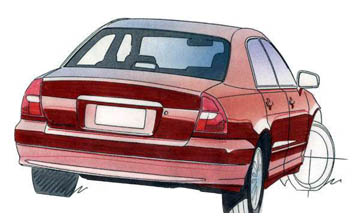BY MALCOLM LIVERMORE | 6th Jun 2001

Being a product developed in Australia, a station wagon variant is a must to successfully compete against the home-grown Holdens and Fords. So a station wagon Verada joined the range in March, 1997.
As the luxurious Diamante, this Mitsubishi is exported. In the US, for instance, it rivals the likes of upscale Hondas and smaller Lexuses, Audis, Mercedes and BMW models.
In May, 1999, the Magna/Verada range received its mid-life facelift.
While the biggest changes surrounded the inclusion of the Verada's 147kW, 3.5-litre V6 in higher spec Magna models (and the demise of the underrated 2.4-litre four-cylinder Magna), only minor changes herald the KH series Verada.
A horizontally slated chrome-tipped grille, revised tail-lights and new-look alloy wheels sum up the exterior changes.
The base Verada Ei gains an eight-speaker, six-stacker CD player, white-faced, red-needled Liquid Crystal Display instrumentation, fake-wood trim, and most importantly, to keep all that torque in check, a traction control device.
This is on top of the already standard dual airbags, remote central locking, automatic climate control air-conditioning and trip computer.
A Magna with the lot sums up the sumptuous Verada Xi.
Leather trim, new interior colours, an electrically adjustable driver's seat, an altered centre console, even more wood-look applique to the centre console, a sunroof, steering wheel mounted audio controls and larger (16-inch) alloy wheels differentiate the Xi from its cheaper brethren.
But like the popular Magna 3.5, the Verada uses a multi-link rear suspension system and a "fuzzy logic" automatic transmission.
Mitsubishi claims the 3.5-litre V6 is one of the most advanced locally-produced engines, developing a more than adequate 147kW at 5000rpm and 300Nm of torque at 4000rpm.
This compares with 140Kw at 5500rpm and 255Nm at 4500rpm for the 3.0-litre version in the base model Magna models.
Using a single overhead camshaft per cylinder bank, the engine goes a long way towards ensuring the Verada not only gives the required amount of performance but matches the levels of refinement buyers in this class demand.
Acceleration from off the line to high-speed overtaking is impressive. But it is the smooth, refined way the engine delivers its grunt that distinguishes this V6.
Only at high revs does it produce enough noise to make its presence felt and even then its makes a pleasant V6 hum.
The only transmission choice is a sophisticated, electronically- controlled, four-speed automatic. Buyers wishing to change their own gears need to look further down the range to the identically engined five-speed manual Magna Sports.
"Fuzzy logic" is a feature of the automatic gearbox. It adapts change-up points according to the road conditions and driving style, thus ensuring smooth, clean changes.
The MacPherson strut front and multi-link rear ends have been tuned to deliver a ride-orientated compromise, suitable for the prestige end of the upper-medium market but a little disappointing to drivers who may also be considering a Peugeot 406 V6, for instance.
It is not bad by any stretch of the imagination, just a little soft compared to the finely balanced setup available in the Magna models.
Overall, Mitsubishi's engineers have still got the ride/handling balance just about right when compared to the other Australian- made luxury cars.
But the larger 16-inch wheels and tyres used in the Verada produce a little more tyre noise than the 15-inch items fitted to the cheaper Magna.
The seats provide decent support and a comfortable ride.
Match this to the Verada's low noise levels - road and wind noise, like the engine, are seldom heard - and the car is a relaxing place to be.
The power steering is a little slow at low speed, an impression not helped by the rather large leather-covered wheel.
Demerit points are also awarded for the crude tilt mechanism which moves the wheel up and down in stages. This means it is usually either too high or too low for an ideal driving position.
The Verada is still distinguishable from the Magna by its four- round headlights which are covered by a single glass panel, a more prominent grille and larger L-shaped tail-lights.
Bigger bumpers front and rear, which can withstand an 8km/h bump without damage, give the Verada a longer and more aggressive look.
The Verada's combination of pace, equipment and overall refinement should ensure its continuing success.
It is certainly among the smoothest and quietest cars produced by the Australian makers, especially considering it is now the oldest design, dating back from 1996.
So good is the Aussie Verada that it earns Mitsubishi some well-earned export credits against big priced, big name rivals.
- Automotive NetWorks, 01/06/1999